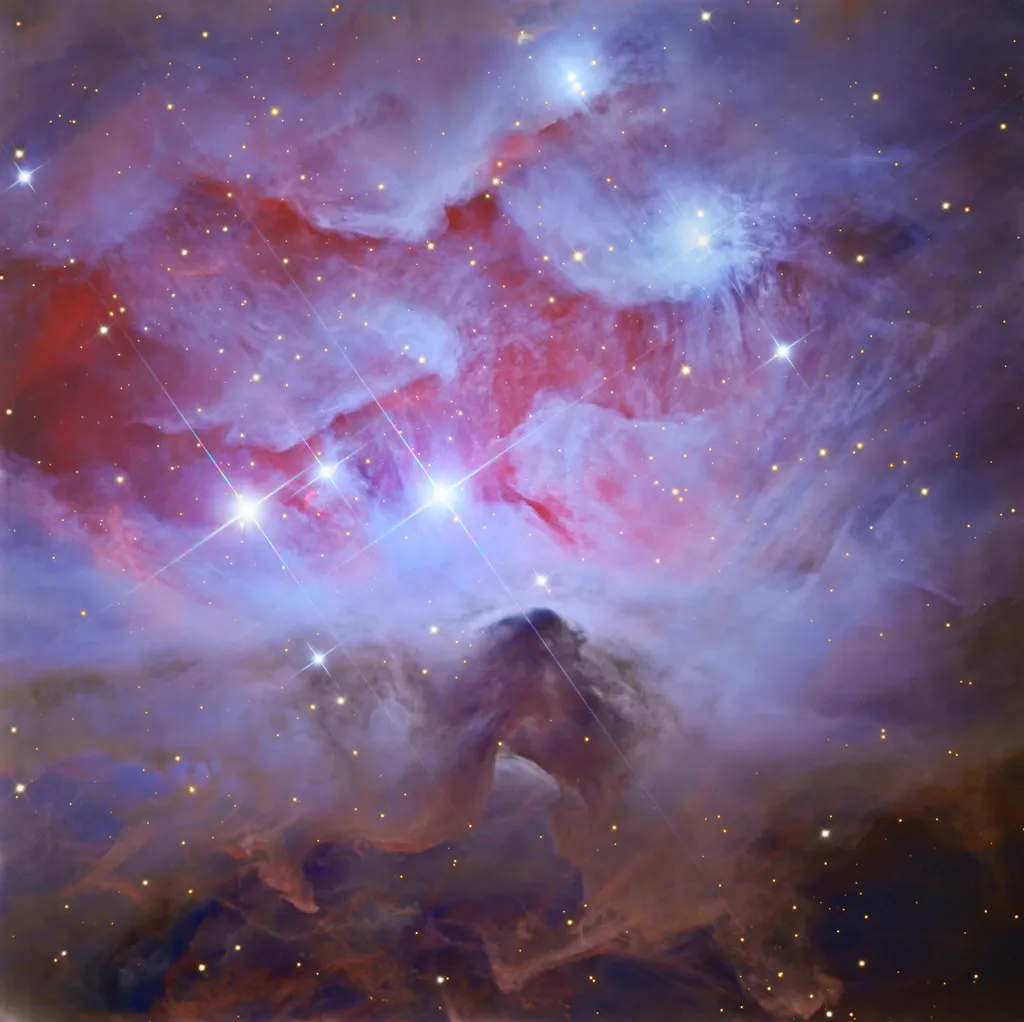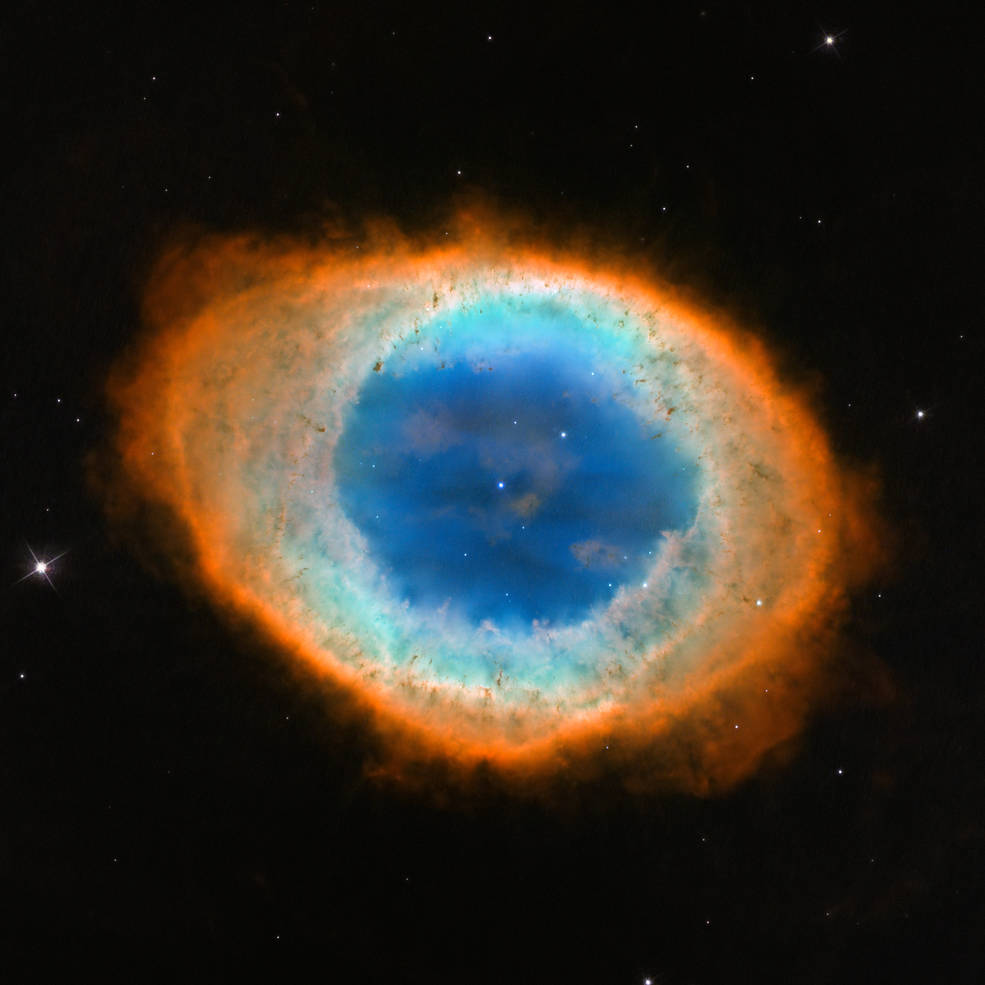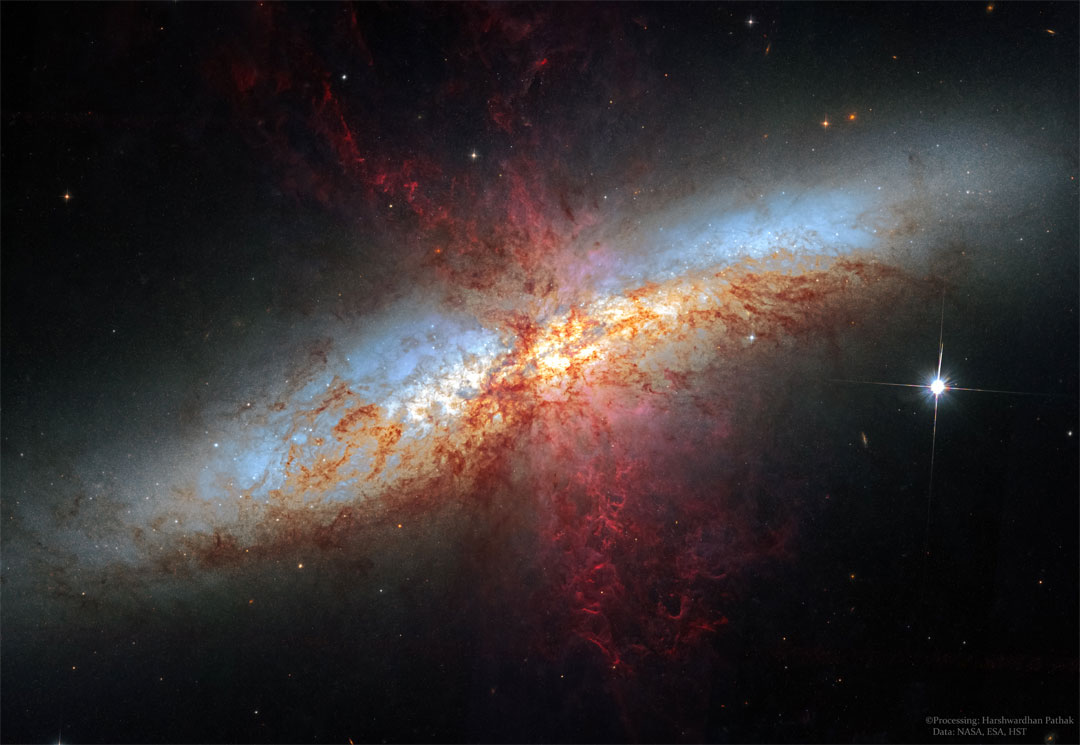Blog
Performing with the music 6pm Shabbat service at Temple Israel with Inbal Sharett-Singer.
more...
Sh2-279 (alternatively designated S279 or Sharpless 279) is an HII region and bright nebulae that includes a reflection nebula located in the constellation Orion. It is the northernmost part of the asterism known as Orion’s Sword, lying 0.6° north of the Orion Nebula. The reflection nebula embedded in Sh2-279 is popularly known as the Running Man Nebula.
Sh2-279 comprises three NGC nebulae, NGC 1973, NGC 1975, and NGC 1977 that are divided by darker nebulous regions. It also includes the open cluster NGC 1981. The brightest nebulosity, later listed as NGC 1977, was discovered by William Herschel in 1786. He catalogued it as “H V 30” and described “!! 42 Orionis and neb[ula]”. The two smaller reflection nebulae were first noted by German astronomer Heinrich Louis d’Arrest, NGC 1973 in 1862 and NGC 1975 in 1864. All three were included in the New General Catalogue in 1888. The designation NGC 1977 is used in various sources for the reflection area around 42 Orionis (the south-east portion of the reflection nebula), for the entire reflection nebula (including NGC 1973 and NGC 1975), or for the whole nebula complex.

Huey “Sonny” Simmons (August 4, 1933 – April 6, 2021) was an American jazz musician.
Simmons was born on August 4, 1933 in Sicily Island, Louisiana.He grew up in Oakland, California, where he began playing the English horn.[3] (Along with Vinny Golia, Simmons was among the few musicians to play the instrument in a jazz context.) At age 16 he took up the alto saxophone, which became his primary instrument. Simmons played primarily in an avant-garde style, often delving into free jazz.
His then-wife, Barbara Donald, played trumpet on several of his early records, including his ESP-Disk titles Staying on the Watchand Music from the Spheres; Arhoolie title Manhattan Egos, and Contemporary titles Rumasuma and the double album Burning Spirits.
Simmons also partnered with Prince Lasha on several recordings, two of which – The Cry! (1963) and Firebirds (1968) – were released by Contemporary.
Personal problems derailed both his music career and home life, leading to divorce and homelessness. He busked on the streets of San Francisco for many years, until he resurrected his career in the early 1990s and began playing in night clubs again.
His resurgence in the mid-1990s was marked by two albums, Ancient Ritual and American Jungle, for Quincy Jones‘ Qwest Records, along with regular appearances in European jazz festivals such as the Moers Festival and Saalfelden Jazz Festival.
more...Mitchell Herbert Ellis (August 4, 1921 – March 28, 2010) was an American jazz guitarist. During the 1950s, he was in a trio with pianist Oscar Peterson. Born in Farmersville, Texas and raised in the suburbs of Dallas, Ellis first heard the electric guitar performed by George Barnes on a radio program. This experience is said to have inspired him to take up the guitar. He became proficient on the instrument by the time he entered North Texas State University. Ellis majored in music, but because they did not yet have a guitar program at that time, he studied the string bass. Unfortunately, due to lack of funds, his college days were short-lived. In 1941, Ellis dropped out of college and toured for six months with a band from the University of Kansas.
In 1943, he joined Glen Gray and the Casa Loma Orchestra, and it was with Gray’s band that he got his first recognition in the jazz magazines. After Gray’s band, Ellis joined the Jimmy Dorsey band where he played some of his first recorded solos.
more...Louis Daniel Armstrong (August 4, 1901 – July 6, 1971 NOLA), nicknamed “Satchmo“, “Satch“, and “Pops“,was an American trumpeter and vocalist. He was among the most influential figures in jazz. His career spanned five decades and several eras in the history of jazz. He received numerous accolades including the Grammy Award for Best Male Vocal Performance for Hello, Dolly! in 1965, as well as a posthumous win for the Grammy Lifetime Achievement Award in 1972, and induction into the National Rhythm & Blues Hall of Fame in 2017.
Armstrong was born and raised in New Orleans. Coming to prominence in the 1920s as an inventive trumpet and cornet player, Armstrong was a foundational influence in jazz, shifting the focus of the music from collective improvisation to solo performance. Around 1922, he followed his mentor, Joe “King” Oliver, to Chicago to play in the Creole Jazz Band. He earned a reputation at “cutting contests“, and his fame reached band leader Fletcher Henderson. He moved to New York City, where he becamhttps://www.youtube.com/watch?v=ThudMtzD3Ioe a featured and musically influential band soloist and recording artist. By the 1950s, he was a national musical icon, assisted in part, by his appearances on radio and in film and television, in addition to his concerts.
His best known songs include “What a Wonderful World“, “La Vie en Rose“, “Hello, Dolly!“, “On the Sunny Side of the Street“, “Dream a Little Dream of Me“, “When You’re Smiling” and “When the Saints Go Marching In“. He collaborated with Ella Fitzgerald producing three records together Ella and Louis (1956), Ella and Louis Again (1957), and Porgy and Bess (1959). He also appeared in films such as A Rhapsody in Black and Blue (1932), Cabin in the Sky (1943), High Society (1956), Paris Blues (1961), A Man Called Adam (1966), and Hello, Dolly! (1969).
With his instantly recognizable rich, gravelly voice, Armstrong was also an influential singer and skillful improviser, bending the lyrics and melody of a song. He was also skilled at scat singing. By the end of Armstrong’s life, his influence had spread to popular music in general. Armstrong was one of the first popular African-American entertainers to “cross over” to wide popularity with white (and international) audiences. He rarely publicly discussed racial issues, to the dismay of fellow African Americans, but took a well-publicized stand for desegregation in the Little Rock crisis. He was able to access the upper echelons of American society at a time when this was difficult for black men.
more...On August 10, Farruquito will grace the stage of the Baluarte de la Candelaria with his show ‘Intimate’. Manuel Valencia will play the guitar, and Paco Vega will handle percussion. The cante (song) will be accompanied by Mari Vizárraga, Ezequiel Montoya ‘Chanito,‘ and Ismael de la Rosa ‘El Bola.‘
more...M57, or the Ring Nebula, is a planetary nebula, the glowing remains of a sun-like star. The tiny white dot in the center of the nebula is the star’s hot core, called a white dwarf. M57 is about 2,000 light-years away in the constellation Lyra, and is best observed during August. Discovered by the French astronomer Antoine Darquier de Pellepoix in 1779, the Ring Nebula has an apparent magnitude of 8.8 and can be spotted with moderately sized telescopes.
M57 is tilted toward Earth so that astronomers see the ring face-on. This gorgeous, high-resolution Hubble image helped astronomers determine that the nebula’s shape is more complicated than initially thought. The blue gas in the nebula’s center is actually a football-shaped structure seen end-on that pierces the red, doughnut-shaped material. The inner rim of the ring displays an intricate structure of dark, irregular knots of dense gas that the stellar winds have not yet been able to blow away. The knots and their tails look like spokes in a bicycle.
This image of M57 has been colorized to illustrate the nebula’s chemical composition. The deep blue color in the center represents helium, the light blue color of the inner ring is the glow of hydrogen and oxygen, and the reddish color of the outer ring is from nitrogen and sulfur.

Anthony Dominick Benedetto (August 3, 1926 – July 21, 2023), known professionally as Tony Bennett, was an American jazz and traditional pop singer. He received many accolades, including 20 Grammy Awards, a Lifetime Achievement Award, and two Primetime Emmy Awards. Bennett was named an NEA Jazz Master and a Kennedy Center Honoree and founded the Frank Sinatra School of the Arts in Astoria, Queens, New York. He sold more than 50 million records worldwide and earned a star on the Hollywood Walk of Fame.
Bennett began singing at an early age. He fought in the final stages of World War II as a U.S. Armyinfantryman in the European Theater. Afterward, he developed his singing technique, signed with Columbia Records and had his first number-one popular song with “Because of You” in 1951. Several popular tracks such as “Rags to Riches” followed in early 1953. He then refined his approach to encompass jazz singing. He reached an artistic peak in the late 1950s with albums such as The Beat of My Heart and Basie Swings, Bennett Sings. In 1962, Bennett recorded his signature song, “I Left My Heart in San Francisco“. His career and personal life experienced an extended downturn during the height of the rock music era. Bennett staged a comeback in the late 1980s and 1990s, putting out gold record albums again and expanding his reach to the MTV Generation while keeping his musical style intact.
Bennett continued to create popular and critically praised work into the 21st century. He attracted renewed acclaim late in his career for his collaboration with Lady Gaga, which began with the album Cheek to Cheek(2014); the two performers toured together to promote the album throughout 2014 and 2015. With the release of the duo’s second album, Love for Sale (2021), Bennett broke the individual record for the longest run of a top-10 album on the Billboard 200 chart for any living artist; his first top-10 record was I Left My Heart in San Francisco in 1962. Bennett also broke the Guinness World Record for the oldest person to release an album of new material, at the age of 95 years and 60 days.
In February 2021, Bennett revealed that he had been diagnosed with Alzheimer’s disease in 2016. Due to the slow progression of his illness, he continued to record, tour, and perform until his retirement from concerts due to physical challenges, which was announced after his final performances on August 3 and 5, 2021, at Radio City Music Hall.
more...Lucky Philip Dube (pronounced duu-beh; 3 August 1964 – 18 October 2007) was a South African reggaemusician and Rastafarian. His record sales across the world earned him the Best Selling African Musician prize at the 1996 World Music Awards. In his lyrics, Dube discussed issues affecting South Africans and Africans in general to a global audience. He recorded 22 albums in a 25-year period and was Africa’s best-selling reggae artist of all time. Dube was murdered in the Johannesburg suburb of Rosettenville on the evening of 18 October 2007.
On 18 October 2007, Lucky Dube was killed by armed robbers in Rosettenville, a Johannesburg suburb, shortly after dropping two of his seven children off at their uncle’s house. Dube was driving his Chrysler 300C, which the assailants were after. Police reports suggest he was shot dead by carjackers who did not recognise him and believed that he was Nigerian. Five men were arrested in connection with the murder; three were tried and found guilty on 31 March 2009. Two of the men attempted to escape and were caught. Dube’s convicted killers were sentenced to life in prison.
more...Roscoe Mitchell (born August 3, 1940) is an American composer, jazz instrumentalist, and educator, known for being “a technically superb – if idiosyncratic – saxophonist”. The Penguin Guide to Jazzdescribed him as “one of the key figures” in avant-garde jazz; All About Jazz stated in 2004 that he had been “at the forefront of modern music” for more than 35 years. Critic Jon Pareles in The New York Timeshas mentioned that Mitchell “qualifies as an iconoclast”. In addition to his own work as a bandleader, Mitchell is known for cofounding the Art Ensemble of Chicago and the Association for the Advancement of Creative Musicians (AACM).
Mitchell, who is African American, was born in Chicago, Illinois, United States. He also grew up in the Chicago area, where he played saxophone and clarinet at around age twelve. His family was always involved in music with many different styles playing in the house when he was a child as well as having a secular music background. His brother, Norman, in particular was the one who introduced Mitchell to jazz.
more...
Eddie Jefferson (August 3, 1918 – May 9, 1979) was an American jazz vocalist and lyricist. He is credited as an innovator of vocalese, a musical style in which lyrics are set to an instrumental composition or solo. Jefferson himself claims that his main influence was Leo Watson. Perhaps Jefferson’s best-known song is “Moody’s Mood for Love” which was recorded in 1952, though two years later a recording by King Pleasurecatapulted the contrafact into wide popularity (King Pleasure even cites Jefferson as a personal influence). Jefferson’s recordings of Charlie Parker‘s “Parker’s Mood” and Horace Silver‘s “Filthy McNasty” were also hits.
Jefferson was born in Pittsburgh, Pennsylvania, United States. One of his most notable recordings, “So What“, combined the lyrics of artist Christopher Acemandese Hall with the music of Miles Davis to highlight his skills, and enabled him to turn a phrase, into his style he calls jazz vocalese.
Jefferson’s last recorded performance was at the Joe Segal’s Jazz Showcase in Chicago and was released on video by Rhapsody Films. He shared the stand with Richie Cole (alto sax), John Campbell (piano), Kelly Sill (bass) and Joel Spencer (drums). The performance was part of a tour that Jefferson and Cole led together. Their opening night in Detroit, Michigan, was at Baker’s Keyboard Lounge, a jazz club built in the 1930s that has played host to famous musicians including those who spanned the genre with artists as diverse as Dexter Gordon and Sonny Stitt.
A previously unreleased live recording from July 1976 was released in August 2009 as Eddie Jefferson At Ali’s Alley, with the quintet of drummer Rashied Ali featured.
Eddie Jefferson was shot and killed outside Baker’s Keyboard Lounge on May 8, 1979, aged 60. He had left the club with fellow bandleader Cole around 1:35 a.m. and was shot while walking out of the building. A late-model Lincoln Continental was spotted speeding away from the scene. The driver was later picked up by Detroit police and identified as a disgruntled dancer with whom Jefferson once worked and had fired from a gig. The suspect was charged with murder, but was later acquitted in a Detroit criminal trial.
more...M82, as this starburst galaxy is also known, was stirred up by a recent pass near large spiral galaxy M81. This doesn’t fully explain the source of the red-glowing outwardlyexpanding gas and dust, however. Evidence indicates that this gas and dust is being driven out by the combined emerging particle winds of many stars, together creating a galactic superwind. The dust particles are thought to originate in M82’s interstellar medium and are actually similar in size to particles in cigar smoke. The featured photographic mosaic highlights a specific color of red light strongly emitted by ionized hydrogen gas, showing detailed filaments of this gas and dust. The filaments extend for over 10,000 light years. The 12-million light-year distant Cigar Galaxy is the brightest galaxy in the sky in infrared light and can be seen in visible light with a small telescope towards the constellation of the Great Bear (Ursa Major).

Nicola James Capaldi (2 August 1944 – 28 January 2005) was an English singer-songwriter and drummer. His musical career spanned more than four decades. He co-founded the progressive rock band Traffic in 1967 with Steve Winwood with whom he co-wrote the majority of the band’s material. He was inducted into the Rock and Roll Hall of Fame as a part of Traffic’s original lineup.
Capaldi also performed with Jimi Hendrix, Eric Clapton, George Harrison, Alvin Lee, Cat Stevens, and Mylon LeFevre, and wrote lyrics for other artists, such as “Love Will Keep Us Alive” and “This is Reggae Music”. As a solo artist he scored more than a half dozen chart hits in various countries, the best-known being “That’s Love” as well as his cover of “Love Hurts“.
more...August 2nd 1938. Phila.and South Jersey`s finest Jazz Guitarist, plays music for any occasion,from solo Guitar to big band music,45 years experience from Las Vegas clubs, to “Mike Douglas Show” to Cancun Jazz Festival(1992). Played two inaugurations for President Reagan(“81″ and”85”), Played in the East room of the White House for President Bush`s 1992 Christmas party. Conducted and played for Frankie Avalon, Bobby Rydell, Paul Anka, Connie Francis, Annette Funicello, Peggy Lee, various jazz groups etc., also Guitar teacher for 30 years.
more...More Posts
- World Fusion with Nordic Raga
- Daily Roots with Tony Clarke
- “Second Chance” by zAmya Theater East Phillips Park
- Rhythm Roots Workshop PRI Minneapolis
- The Cosmos with NGC 1892
- Nicholas Payton Day
- George Gershwin Day
- World Music with Northern Cree
- Daily Roots with Slyford Walker
- Rhythm Roots Workshop at PRI St Louis Pk
- The Cosmos with NGC 6872
- Sam Rivers Day
- Shadow Wilson Day
- World Music with Noe hernandez cantarell
- Daily Roots with the Twinkle Brothers
- The Cosmos with NGC 3981
- Fats Navarro Day
- Blind Melon Jefferson Day
- World Music with Eugenia Georgieva
- Daily Roots with Playing for Change